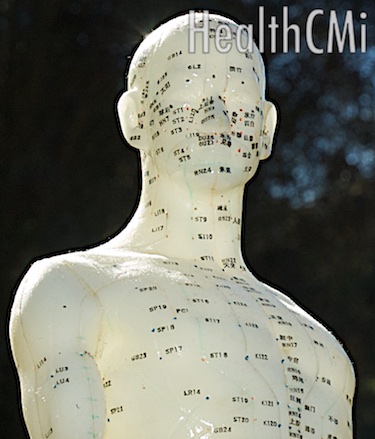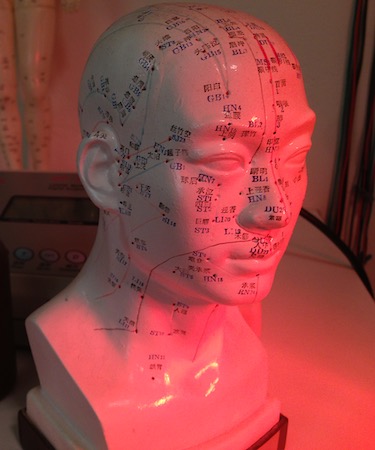Acupuncture reduces cholesterol. Researchers measured the effects of needling acupuncture point ST40 (Fenglong) on plasma cholesterol levels. In a laboratory experiment, electroacupuncture successfully downregulated LDL cholesterol. Simultaneously, electroacupuncture downregulated several proinflammatory macrophages linked to dyslipidemia: MCP-1, ICAM-1, IL-1gamma. The researchers conclude that electroacupuncture at ST40 downregulates plasma total cholesterol, LDL cholesterol and proinflammatory macrophages in cases of hyperlipidemia.
A related laboratory experiment reveals similar findings. Zhang, et. al., conclude that electroacupuncture lowers levels of cholesterol and triglycerides in cases of high cholesterol. Acupuncture points LI11 (Quchi), CV12 (Zhongwan) and ST40 effectively lowered LDL cholesterol, total cholesterol and triglycerides.
Nitric Oxide
Ling Li, et. al., concur that acupuncture lowers both cholesterol and triglycerides. The laboratory research measured biochemical responses to electroacupuncture at acupoint ST40 to map the mechanisms by which acupuncture reduces hyperlipidemia. The study documents that electroacupuncture induces expression of nNOS and Mt1. The NNOS enzyme mediates nitric oxide signaling and plays an important role in cellular signaling, vascular tone, blood pressure, insulin secretion, airway tone, angiogenesis and peristalsis. Mt1 plays an important role in the protection against oxidative stress. Based on these findings, the researchers conclude that electroacupuncture and its effect on nitric oxide signaling transduction is physiologically related to its cholesterol and triglyceride lowering effects.
Foam Cells
Y. F. Chen, et. al., conclude that acupuncture prevents and reverses dangerous cellular accumulations of fatty materials in cases of high cholesterol. The laboratory research confirms that needling ST40 prevents and reverses the formation of foam cells. This type of cell forms at the site of fatty streaks and is the beginning of atherosclerotic plaque formation in blood vessels. The presence of foam cells is indicative of an increased risk of heart attacks and strokes. Based on the research, the investigators note that acupuncture could “play an essential role in treating hyperlipidemia and stopping it from developing into a further level.”
Oxidized LDL cholesterol creates inflammation within blood vessels. Macrophages are attracted to the site of inflammation and consume the LDL cholesterol. Ordinarily, macrophages defend against bacteria and other pathogens. However, macrophages may become engulfed in fatty materials when attempting to eliminate excess cholesterol. Under a microscope, one can see that the macrophages become overrun with cholesterol and other fatty materials. The damaged macrophages take on a foamy appearance, hence the name foam cell. Foam cells indicate that dangerous plaques are beginning to form within the vessels. The researchers conclude that electroacupuncture at acupuncture point ST40 “prevents and reverse(s) the formation of foam cell(s).” In this way, acupuncture helps to fight hyperlipidemia and prevent heart disease.
The research demonstrates that electroacupuncture at ST40 “significantly prohibits the transformation of macrophage(s) into foam cell(s).” The researchers measured sharp reductions in foam cells as a result of acupuncture. Stimulation of acupoint ST40 was shown to decrease the cholesterol content of macrophages.
Cells decrease cholesterol levels can in two ways. The first way is to convert cholesterol into cholesterol esters.  This method is limited because it may overrun cells with esters and consequent toxicity. Needling acupuncture point ST40 accomplishes cholesterol reduction by another method that is completely non-toxic. ST40 stimulation increases the rate of cholesterol efflux from macrophages. Cholesterol efflux is a process of eliminating cholesterol from cells that is regulated by intracellular transporters including ATP proteins A1, G1 and B1. Unlike the cholesterol ester process, the efflux process has a virtually unlimited capacity to reduce cholesterol because there is no danger of building up excess cellular cholesterol esters. Needling ST40 with electroacupuncture activates an important, safe and powerful method for cells to reduce excess cholesterol content.
This method is limited because it may overrun cells with esters and consequent toxicity. Needling acupuncture point ST40 accomplishes cholesterol reduction by another method that is completely non-toxic. ST40 stimulation increases the rate of cholesterol efflux from macrophages. Cholesterol efflux is a process of eliminating cholesterol from cells that is regulated by intracellular transporters including ATP proteins A1, G1 and B1. Unlike the cholesterol ester process, the efflux process has a virtually unlimited capacity to reduce cholesterol because there is no danger of building up excess cellular cholesterol esters. Needling ST40 with electroacupuncture activates an important, safe and powerful method for cells to reduce excess cholesterol content.
The recent foam cell research on the beneficial effects of acupuncture on macrophages comes at a time when other remarkable research has emerged. Recently, an investigation published in Molecular Neurobiology reveals that acupuncture reduces inflammation and muscle pain by downregulating M1 macrophages (proinflammatory cells) and upregulating M2 macrophages (antiinflammatory cells). The study measured responses in muscle tissues and confirms that M1 to M2 macrophage phenotype switching is triggered by acupuncture stimulation. Acupuncture stimulates biological actions wherein inflammatory responses are reduced and cellular healing responses are initiated.
References:
Tian, J. Y., Q. Wang, Y. F. Chen, Y. Xiao, W. Yue, and H. X. Zhang. "[Effect of electroacupuncture stimulation of" Fenglong"(ST 40) on expression of inflammatory cytokines of celiac macrophages in hyperlipidemia rats]." Zhen ci yan jiu= Acupuncture research/[Zhongguo yi xue ke xue yuan Yi xue qing bao yan jiu suo bian ji] 39, no. 4 (2014): 282-287.
Papayianni, Aikaterini, Efstathios Alexopoulos, Panagiotis Giamalis, Lazaros Gionanlis, Anna‐Maria Belechri, Paraschos Koukoudis, and Dimitrios Memmos. "Circulating levels of ICAM‐1, VCAM‐1, and MCP‐1 are increased in haemodialysis patients: association with inflammation, dyslipidaemia, and vascular events." Nephrology Dialysis Transplantation 17, no. 3 (2002): 435-441.
Zhang, G. X., J. L. Miao, Z. Y. Zhang, H. J. Wang, and L. X. Ji. "Regulation effects of electroacupuncture with different acupoint combinations on blood lipid in rats with hyperlipemia." Zhongguo zhen jiu= Chinese acupuncture & moxibustion 34, no. 9 (2014): 894.
BIOTECHNOLOGY LETTERS. 2012, DOI: 10.1007/s10529-012-0892-9. Modulated expression of genes associated with NO signal transduction contributes to the cholesterol-lowering effect of electro-acupuncture. Ling Li, Guang-Hong Tan and Yi-Zheng Zhang.
Chen, Y. F., J. Y. Tian, Y. Xiao, H. Wu, H. Huang, and H. X. Zhang. "Effects of electroacupuncture at" Fenglong"(ST 40) on formation of macrophage-derived foam cell and efflux of cholesterol in hyperlipidemia rats." Zhongguo zhen jiu= Chinese acupuncture & moxibustion 34, no. 5 (2014): 475.
Low H1, Hoang A, Sviridov D. Cholesterol efflux assay. J Vis Exp. 2012 Mar 6;(61):e3810. doi: 10.3791/3810.
da Silva, Morgana D., Franciane Bobinski, Karina L. Sato, Sandra J. Kolker, Kathleen A. Sluka, and Adair RS Santos. "IL-10 Cytokine Released from M2 Macrophages Is Crucial for Analgesic and Anti-inflammatory Effects of Acupuncture in a Model of Inflammatory Muscle Pain." Molecular Neurobiology (2014): 1-13.


